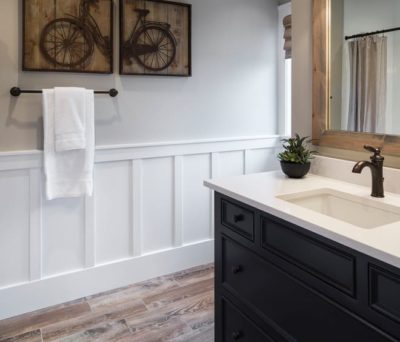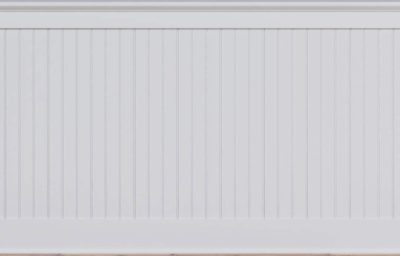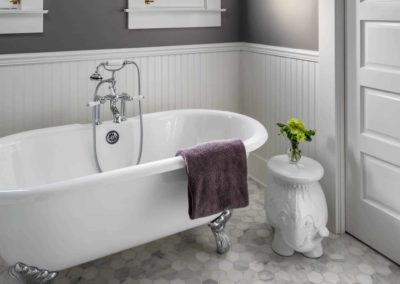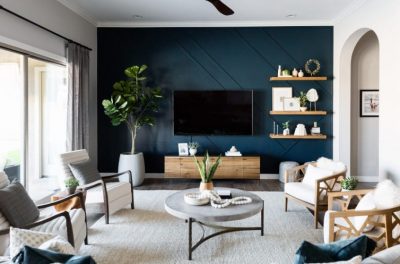Some people may argue that wainscoting exists solely for decorative purposes while others may refute that it functions to protect the structural integrity of a wall. There’s no point in arguing though—wainscoting gives any room (dining room, bathroom, and living room most commonly) that whole put-together look while serving as a wall’s first layer of defense. So I put together the simple guide to help you decide the best wainscoting for your next project.
The 3 Different Styles of Wainscoting
There are three main styles of wainscoting: raised panel, flat panel, and beadboard. Under these three styles are several more subtypes, each of which is fun to explore, especially if you’re in the process of building or redecorating your home and looking for wainscoting ideas.
1. Raised Panel
Characterized by an elevated center and a sloping edge, raised panel wainscoting dates back to the colonial era and is the most classical of all wainscoting styles. This type of wainscoting is regarded as the most expensive style but is still favored by real estate developers because of the regal drama it brings to the room. Raised panel wainscoting is commonly installed in the dining room, living room, study and library, foyer and stairwell, and Victorian homes.
2. Flat Panel
Also called “recessed panel” wainscoting, flat panel is less expensive and easier to install than raised panel wainscoting because of its thin panels. Homebuilders who go for a clean and modern aesthetic usually favor this type of wainscoting. You’ll see this labeled as board and batten wainscoting sometimes as well since it’s a derivative of flat panel wainscoting.
3. Beadboard
Of the three main styles of wainscoting, beadboard wainscoting panels are the most simple and affordable. Originating in the late Victorian era, beadboard wainscoting was popularly installed in “back-of-the-house” areas or rooms that were not commonly used to receive guests such as the kitchen. This type of wainscoting is characterized by uniformly spaced grooves and is still a favorite choice among practical homeowners. A chair rail is usually added above it to complete the look.
The other types of wainscoting are mostly a variation of the main 3 styles, they include:
Beaded Raised Panel
Think of these wainscoting panels as the raised panel made extra fancy, with half an inch of sloping edge that creates that much elegant difference.
Beaded Recessed Panel
This is the beaded counterpart of the flat panel type of wainscoting, with two intricately-detailed curves on the beaded edge for that added flair.
Classic Recessed Panel
Also a variation of the flat panel, classic recessed wainscoting panels showcase a beaded edge with one curve, unlike the beaded recessed panel that has two.
Wall Paneled
A favorite choice among DIYers for its relatively easier installation, wall paneled wainscoting makes good use of the already existing drywall in the center instead of relying on a panel.
Overlay Panel
Overlay wainscoting panels marry the dramatic features of the raised panel and the flat panel, with a majestic board installed across the middle.
Board-and-Batten
Another popular DIY choice because of its easy installation, board-and-batten wainscoting is a quick way to add impressive height to any room, especially when installed floor-to-ceiling. Think of board and batten as the flat panel’s tall and lean brother. I’ve seen board and batten wainscoting used for entire walls!
Picture Frame Wainscoting
Picture frame wainscoting is exactly what it sounds like—akin to having an ornate picture frame mounted on your wall. Picture frame molding is similar to an overlay panel, except that it is significantly easier and quicker to install.
Other Wainscoting Materials
Traditional wainscoting is made from hardwood panels, but in recent years we have seen a surge in non-traditional materials such as PVC plastic, embossed metal, and ceramic tile. Home improvement blogsite This Old House supports the use of non-traditional wainscoting materials because they are both affordable and durable, and as with traditional wainscoting, instantly glam up any home.
Read Also: If you’d like more Wainscoting Ideas with photos, please check out 34 Wainscoting Ideas for Every Wall in Every Room.
Where did Wainscoting come from?
As recorded by Encyclopædia Britannica, the popularity of wainscoting took flight in the early English Renaissance. With oak sourced from Russia, Germany, or Holland, wainscoting was typically accompanied by grandiose paintings, sculptures, and other works of art. Measuring at 8 to 10 feet in height, it lent understated elegance to any home.
What is the purpose of wainscoting?
The original functional purpose of wainscoting, however, was not as elegant. Instead, it was a wall covering to conceal damp spots on walls, a common result of poor plumbing and inadequate insulation. As plumbing and insulation technologies grew sophisticated, home developers maintained the use of wainscoting to elevate a home’s aesthetics and value. It’s common to add a chair rail above it to further enhance the look and protect walls in a dining room.
Should You DIY Your Home’s Wainscoting?
Every practical homemaker’s first thought when planning to embark on a home improvement project is, “Can I DIY it?” DIY home improvement projects are a great way of upgrading your house while saving some serious bucks. With DIYs, you get to stick to mostly just the material cost and do away with contractor and labor costs.
DIY rule of thumb: before starting a DIY project—especially a major one—make sure that you are equipped with adequate know-how, savvy with tools, not pressed for time, and not a stranger to DIYs. A successful DIY undertaking translates to savings, but a failed one? That may cost you more money than if you had hired a professional in the first place.
Here are some important tips from former real estate attorney turned interior design blogger Sue De Chiara of The Zhush:
- The cost of a DIY wainscoting project averages at $5 to $45 per square foot, depending on your chosen wainscoting style and material. As only logical, the more high-end your choices are, the more expensive your project will get. For example, solid wood wainscoting will cost you more than PVC plastic. And don’t forget the chair rail, you’ll have to factor in that cost as well.
- Acquaint yourself with the different types of wainscoting and check which is most compatible with the overall feel of your home.
- Installing wainscoting requires a serious arsenal of tools: circular saw, jigsaw, hammer, level, tape measure, stud finder, finishing nails, caulk gun, nail gun, and paneling nails. It is essential that you round up all these tools before launching the project. If you do not have these at home, you may want to borrow from your neighborhood handyman or, if you’re serious about DIY home projects, invest in them.
- The first step in installing wainscoting is taking measurements. It is essential that you get the square footage of your required wainscoting panels before anything else.
- A DIY wainscoting installation is absolutely rewarding but it does not come without serious challenges such as constant measurement-taking, some muscle work, and a lot of cleaning.
Read Next: 49 Wainscoting Design Ideas for Every Room
FAQ: Common Questions About Wainscoting
How high should wainscoting be?
Typically, the wainscoting cap sits about a third of the way up the wall in a given room. So, if the wall is 12 feet tall, then the wainscoting cap would be roughly 4 feet up the wall with chair rail. You can go taller if you want. If that’s the case, consider going a full two-thirds up for the cap instead.
Why is it called wainscoting?
The meaning of wainscoting isn’t obvious to most people. The first part of the word, wains, comes the Dutch word for “wagon”. The second half, scot, means “partition” or wall. Literally, wainscoting means something like “wagon wall”. The word originally meant a specific kind of oak tree wood, but over time the term transferred over to the wall paneling itself.
Is wainscoting still in style?
In a word: Yes. Wainscoting provides the ability to visually separate walls from the floor and from the materials used in each one, whether it’s wallpaper, paneling, painted panels, artwork, or anything else. Painted Board and Batten in any color other than white is huge right now.
Is wainscoting expensive?
This depends on a number of factors, including the amount of wainscot you’ll need and the materials that you plan to use. Traditionally, you’re looking at around $5 per square foot, on average, though it can be much higher or lower than that.
How wide should wainscoting panels be?
The width of your wainscot panels will determine the look and layout of your wainscoting design, but there’s no set length for how wide they should be. Take a look at the many different types and sizes in this post to see just how widely they vary (pun intended).
What paint finish is best for wainscoting?
For spray painted wainscoting panels, go with a semi-gloss finish. For brush paint, a satin finish looks better, and is often a bit easier to work with as well.
Does wainscoting increase home value?
Yes, definitely. It does this by adding visual “expense” to homebuyers, infuses your walls undeniable charm, requires somewhat little capital to actually install, and ultimately functions as both decoration and a kind of home renovation.
Is wainscoting waterproof?
It can be, though it really depends on the materials and finish you decide to use.
When to use wainscoting?
Truly, you can use it anywhere, but you should look to utilize paneling or wainscoting in any room and foyer where you can really stand back and take it all in. Different styles work better in different rooms and environments.
Does wainscoting go behind baseboards?
Wainscoting or beadboard can go behind or on top of baseboards. If you already have existing baseboards, it might be better to install it above those. For new construction or renovation projects, you can actually purchase baseboards that have a notch built in which to fit the wainscoting.
Does wainscoting make a room look bigger or smaller?
Taller wainscoting, especially in rooms with lower ceilings, can give the appearance or feel of a smaller room. That said, darker colors on wainscoting can also make rooms look and feel on the smaller side. To employ wainscoting to give rooms a larger feeling, opt for shorter panels and colors on the lighter end of the spectrum. Read more about how wainscoting affects your room size here: Does Wainscoting Make a Room Look Bigger?













